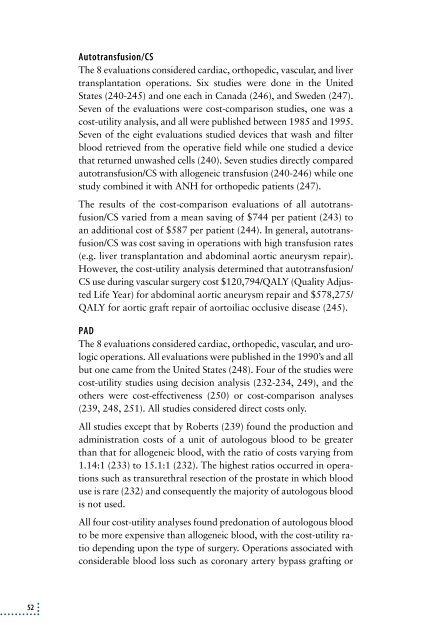Elektronisk udgave - Sundhedsstyrelsen
Elektronisk udgave - Sundhedsstyrelsen
Elektronisk udgave - Sundhedsstyrelsen
You also want an ePaper? Increase the reach of your titles
YUMPU automatically turns print PDFs into web optimized ePapers that Google loves.
52<br />
Autotransfusion/CS<br />
The 8 evaluations considered cardiac, orthopedic, vascular, and liver<br />
transplantation operations. Six studies were done in the United<br />
States (240-245) and one each in Canada (246), and Sweden (247).<br />
Seven of the evaluations were cost-comparison studies, one was a<br />
cost-utility analysis, and all were published between 1985 and 1995.<br />
Seven of the eight evaluations studied devices that wash and filter<br />
blood retrieved from the operative field while one studied a device<br />
that returned unwashed cells (240). Seven studies directly compared<br />
autotransfusion/CS with allogeneic transfusion (240-246) while one<br />
study combined it with ANH for orthopedic patients (247).<br />
The results of the cost-comparison evaluations of all autotransfusion/CS<br />
varied from a mean saving of $744 per patient (243) to<br />
an additional cost of $587 per patient (244). In general, autotransfusion/CS<br />
was cost saving in operations with high transfusion rates<br />
(e.g. liver transplantation and abdominal aortic aneurysm repair).<br />
However, the cost-utility analysis determined that autotransfusion/<br />
CS use during vascular surgery cost $120,794/QALY (Quality Adjusted<br />
Life Year) for abdominal aortic aneurysm repair and $578,275/<br />
QALY for aortic graft repair of aortoiliac occlusive disease (245).<br />
PAD<br />
The 8 evaluations considered cardiac, orthopedic, vascular, and urologic<br />
operations. All evaluations were published in the 1990’s and all<br />
but one came from the United States (248). Four of the studies were<br />
cost-utility studies using decision analysis (232-234, 249), and the<br />
others were cost-effectiveness (250) or cost-comparison analyses<br />
(239, 248, 251). All studies considered direct costs only.<br />
All studies except that by Roberts (239) found the production and<br />
administration costs of a unit of autologous blood to be greater<br />
than that for allogeneic blood, with the ratio of costs varying from<br />
1.14:1 (233) to 15.1:1 (232). The highest ratios occurred in operations<br />
such as transurethral resection of the prostate in which blood<br />
use is rare (232) and consequently the majority of autologous blood<br />
is not used.<br />
All four cost-utility analyses found predonation of autologous blood<br />
to be more expensive than allogeneic blood, with the cost-utility ratio<br />
depending upon the type of surgery. Operations associated with<br />
considerable blood loss such as coronary artery bypass grafting or

















